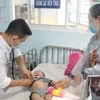The National Leprosy Eradication Programme under the Health Ministry and the Lam Dong provincial People’s Committee on Sept. 25 organised a conference aiming to accelerate efforts to eradicate leprosy.
According to the programme’s management board, in 2000, the World Health Organisation (WHO) recognised Vietnam ’s success in eliminating leprosy, bringing the incidence of the disease to under 1 per 10,000 on the national scale.
Since 2002, Vietnam has launched campaigns to erase the disease in accordance with the country’s standards. As a result, in 2010, 42 cities and provinces nationwide fulfilled the targets of bringing the prevalence rate of leprosy to under 0.2 percent per 10,000 people, the annual detection rate of new cases at under 1 per 100,000 for three consecutive years, the rate of disability among newly-discovered patients at under 15 percent, and having 100 percent of randomly-surveyed medical workers and local officials understand the basics of leprosy.
However, 21 remaining cities and provinces, mostly in central, Central Highlands and southern regions, are struggling with leprosy with over 1,000 cases discovered each year.
Delegates at the event proposed a wide range of solutions to eliminate the disease by 2015, focusing on epidemiological monitoring, information work to raise people’s awareness of the epidemic in remote and far-lung areas, and the combination of treatment methods. /.
According to the programme’s management board, in 2000, the World Health Organisation (WHO) recognised Vietnam ’s success in eliminating leprosy, bringing the incidence of the disease to under 1 per 10,000 on the national scale.
Since 2002, Vietnam has launched campaigns to erase the disease in accordance with the country’s standards. As a result, in 2010, 42 cities and provinces nationwide fulfilled the targets of bringing the prevalence rate of leprosy to under 0.2 percent per 10,000 people, the annual detection rate of new cases at under 1 per 100,000 for three consecutive years, the rate of disability among newly-discovered patients at under 15 percent, and having 100 percent of randomly-surveyed medical workers and local officials understand the basics of leprosy.
However, 21 remaining cities and provinces, mostly in central, Central Highlands and southern regions, are struggling with leprosy with over 1,000 cases discovered each year.
Delegates at the event proposed a wide range of solutions to eliminate the disease by 2015, focusing on epidemiological monitoring, information work to raise people’s awareness of the epidemic in remote and far-lung areas, and the combination of treatment methods. /.



















